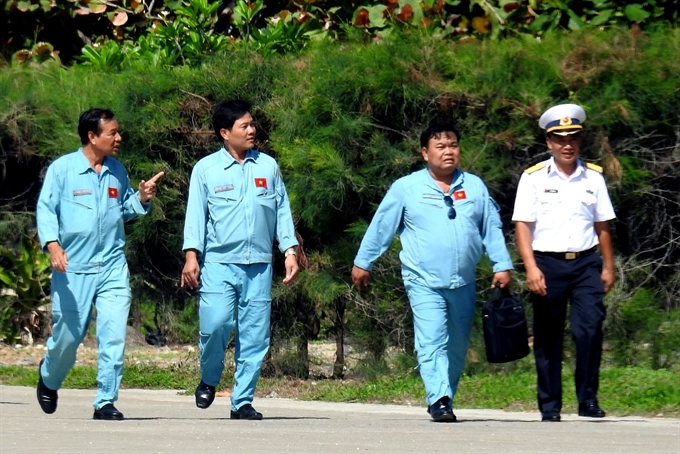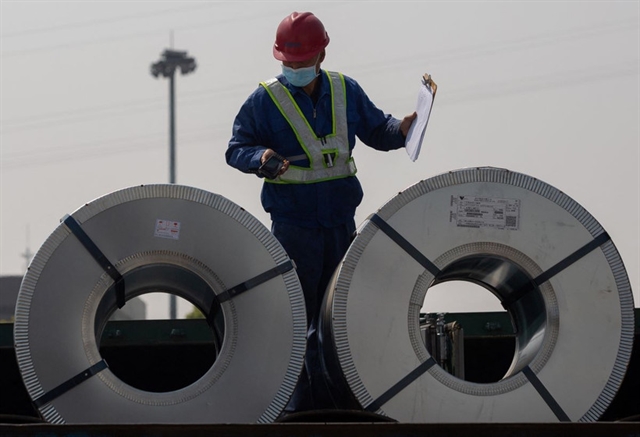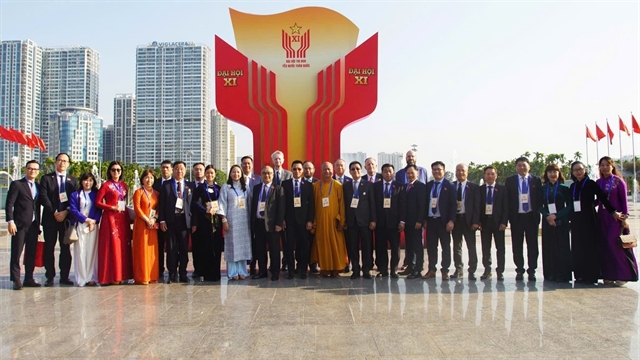 Society
Society

As the nation joins the CASA 8983 and Sukhoi Su-30MKI crew’s loved ones, colleagues and relatives, in their grief, VNS pays its tribute as a reflection on the extraordinary deeds performed by ordinary people.
 |
| (From left to right) Senior Lieutenant Colonel Nguyễn Đức Hảo, Major Nguyễn Văn Chính and Colonel Lê Kiêm Toàn after they landed the CASA 212 aircraft on Trường Sa island for the first time on June 2, 2016. They were among the nine crew members of the ill-fated aircraft. — Photo thanhnien.vn |
by Thu Vân
HÀ NỘI — At 6am on June 16, Senior Lieutenant Colonel Nguyễn Đức Hảo of Brigade 918, received a call from his wife, Ngô Thị Dung.
She was not unduly worried, but wondered why he’d not called her the previous day. In the four years or so that he’d been transferred to Hà Nội from HCM City, there had not been a single day that he’d not called her.
He’d been too tired, Hảo told her, after flying out for nine continuous hours to sea on a rescue mission. Dung had not been following the news very closely, but knew some jet had gone missing. Hảo told her he would have to take another flight soon, so he had to meet with his team early and couldn’t talk for long. The understanding wife made a light-hearted comment: “Don’t fly too far, dear,” she said.
At 7am the same morning, Captain Lê Văn Đình, also in Hảo’s brigade, called his wife Nguyễn Thị Thắm in Thái Nguyên Province. They have a small apartment in Hà Nội, but she’d very recently moved to the province to stay with his parents after giving birth to a baby boy.
Thắm, a bit concerned, told Đình there’d been heavy rain and thunder last night in the province, and asked him if he would have to take any flight that day since it was still raining heavily. He said yes.
“Why,” Thắm asked, adding, “the weather’s really bad.”
“One comrade is still missing. He needs us, he might be in the middle of the ocean waiting for us to rescue him, and we can’t postpone the flight just because the weather is bad. Every minute counts.” Đình said.
It was 10 minutes past 9am when they took off.
Senior Lt. Colonel Nguyễn Đức Hảo and Captain Lê Văn Đình, Air Patrol Specialist, were part of the nine crew members who boarded the CASA-212 maritime patrol aircraft coded 8983 that morning at the Gia Lâm Airbase in the north of Hà Nội.
The crew were at the forefront of the national search and rescue effort for two fighter jet pilots whose Sukhoi Su-30MKI had crashed into the ocean on a training session two days earlier.
There was a renewed sense of hope and urgency among the CASA crew that morning. The day before, one of the two missing pilots had been rescued by a fishing boat as he floated in the ocean. The pilots had parachuted out of the Su-30 after an engine explosion. Hopes were high that the second pilot would be found and saved soon.
The weather was bad, but the crew boasted some of the most experienced Vietnamese military pilots and officers, well equipped to carry out search and rescue operations. In fact, of the two CASA aircraft originally scheduled for the morning patrol, the more experienced crew were chosen by the air-force command to continue the search for the missing pilot.
Colonel Lê Kiêm Toàn, chief of Brigade 918, captain of the CASA-212 flight that day, had logged nearly 3.000 hours on a wide range of military aircraft ranging from L-39 and AN-26 to MIG-21 fighter jets. A respected trainer of many Vietnamese pilots, Toàn had led the aerial search on the East Sea last year for the missing MH370.
There was no inkling or premonition of the tragedy that would claim all nine lives.
Three hours into the search, at 12.27 pm, the CASA 8983 was flying at an altitude of 150 meters. Five minutes later, at 12.32 pm, the Command Centre realized they had lost contact with the CASA.
At 6pm, search teams retrieved key parts of the aircraft at a depth of 50-60m, including the body, tail, propeller, and some personal items of crew members.
The next day, the body of Senior Lieutenant Colonel Trần Quang Khải was found, and nine days later, authorities formally announced what everyone feared and assumed. All the nine crew members of CASA 8983 were dead.
A day that had begun with high hopes had come crashing down to earth in heart-breaking fashion, leaving loved ones to pick up the pieces of their shattered lives.
Sitting in their apartment in Hà Nội, Thắm recalled the happy moments she’d shared with her husband, whom she could only meet a few times every month.
“He was this tall, handsome guy who would always smile at you. He was the kind of person who would make you laugh the whole day,” she said.
Thắm is proud of her husband. Lê Văn Đình was among the Vietnamese army’s elite marine commandos. In an effort to set up an independent sea patrol unit under the Việt Nam Coast Guard, Đình was chosen to join a group of elite forces who would also be trained in air patrols. Several years into his training, Đình took up his Air Patrol Specialist position with the CASA 8983 on the fateful day.
Pointing to a picture of a CASA aircraft coded 8981 hanging high on the wall of the living room, Thắm said her husband loved it.
“When he was home, he would stand silently and look at the picture for a long time,” she said, adding that every member of Đình’s flight team has a similar picture.
He had talked to her about the risks and the dangers of his job, but never thought of quitting, she said.
“He loved flying in the sky. He took a lot of pictures during his flights, beautiful ones of the sky and the landscapes.”
The previous Sunday, ĐÌnh had gone to his parents’ home in Thái Nguyên Province to celebrate the second birthday of Hạ Bình, their first daughter. Lots of pictures and clips were taken then, capturing the abundant love that pervaded his home – his smile when holding his first daughter and the cheerful laughter of the newborn baby boy, Bình Minh, when his father tickled him.
“The word Bình in the names of both our kids means “peace”. Đình said he wants peace for the family, and peace for the country,” Thắm said.
She said what she loved most about her husband most was not his love for his job, but his love for the family.
“In the four years of our marriage, he never said or did anything that made me sad. He’s a caring father – when he came home from Hà Nội, he would always bring all kinds of medicines just in case the kids felt unwell, and diapers for our new born baby.”
Just before the fateful flight, Đình had prepared documents to register their residency in the new apartment and told Thắm that when he returned, he would complete the procedures, and take her and the kids from Thái Nguyên to Hà Nội.
A few years short of his retirement, Nguyễn Đức Hảo would often ask his wife to be patient and wait for the day he could return and work in HCM City.
Hảo, who grew up in a small village in Sơn Đà Commune, Ba Vì District in the north of Hà Nội, was chosen to train in Russia as a pilot soon after joining the Việt Nam Air Force. When he returned, he was sent to work in HCM City. In 2012, when the CASA fleet was established, Hảo was asked to go to Hà Nội as its leader.
“He was a very kind-hearted, down-to-earth man, a loving husband…” said Dung, unable to stop her tears at every mention of Hảo. When she heard the news, she and one of her twin sons flew from HCM City to stay with Hảo’s sister in Hà Nội.
“Because of his work, he has had to stay away from home. But he never complained. Just before the accident, he told me he was hoping that when a new CASA fleet is set up in HCM City, he would be able to come home to our family.
“My husband was the heart and the spirit of the family. He shouldered the most important matters in the family. I don’t know what to do without him…,” she said, tears flowing afresh.
As a soldier’s wife, Dung is stronger than she thinks. When there was almost no hope of his return, Dung decided to get the family together to arrange her husband’s funeral. The only person she did not include in this discussion was Nguyễn Đức Huy, one of her twin sons, who was sitting for examinations at the Nha Trang Air Force Academy.
Sitting in a corner of the room, Nguyễn Đức Duy, the other twin, was silent throughout. Duy had just finished his two years of his military service and was planning to follow in his father’s footsteps. When I gently asked him if he was reconsidering his choice after this tragedy, his eyes turned red and the tears flowed.
But his voice was firm: “No. My father wouldn’t want us to be cowards.” — VNS
Army announces causes of two aircraft crashesThe People’s Army of Việt Nam (PAVN) announced preliminary conclusions on the causes of two tragic military aircraft crashes which occurred this month on Friday. PAVN’s Deputy Chief of the General Staff Senior Lieutenant General Võ Văn Tuấn said in a press conference on Friday - the first press conference held since the two accidents happened - there was “an incident in the cabin which made the pilots jump out of the aircraft and pull their emergency parachutes” in the case of the missing SU-30MK2. This preliminary conclusion was based on information given by surviving pilot Nguyễn Hữu Cường, Tuấn said. “We will have to assess other objective factors for further investigation.” Regarding the CASA-212 aircraft crash that killed nine crew members, Tuấn said the weather was abnormal and unstable during the flight. The ill-fated CASA-212 was on a search mission for the SU30 when it crashed, and this may be part of the reason the aircraft crashed, Tuấn said. “Aircrafts tend to stay low during search and rescue missions,” he said. “Weather and altitude could be factors which combined to cause the accident.” “We are still looking for CASA-212’s black box. We will use the black box information and other factors to reach our final conclusions.” On June 14, the Russian-made fighter jet SU30MK2 (coded 8585 of Regiment 923 under Division 371 of the Air Defence – Air Force Service) crashed into the sea during a training session above the waters off Nghệ An-Thanh Hóa provinces, 40km to the northeast of Hòn Mát Island. Its two pilots, Senior Lieutenant Colonel Trần Quang Khải and Major Nguyễn Hữu Cường, parachuted but only Cường survived. Two days later, while looking for signs of the SU30 jet in the Tonkin Gulf, the surveillance aircraft CASA-212 (coded 8983 of Brigade 918 of the Air Defence – Air Force) went missing, along with its nine crew members. The aircraft went down about 15 nautical miles to the south-southeast of Bạch Long Vỹ Island, 2.7 nautical miles to the west of the Việt Nam-China delimitation line in the Gulf of Tonkin. |




